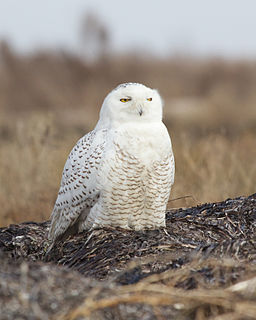Snowy Owl
Nyctea Scandiaca
Written by Kathy Richards
HABITAT:
The snowy owl makes its home in the arctic tundra which is treeless and somewhat flat and covered with moss and lichen. It nests on hummocks (small mounds usually in wetland area) that are 3-4 ft high giving the owl a view of everything around including would be predators. This is top priority for staying in an area.
Some migrate south for the winter starting as early as Nov and staying until April. The migrants tend to be the result of a good breeding season where food was plentiful so many chicks survived. When they migrate they tend to go to the open coastal marshy areas like Logan Airport, prairies, lakeshores, riverbanks, pastures and coastal beaches.
NESTING:
Unlike other owls, the snowy owl nests on the ground. The females lay 7-10 eggs(though they have been known to lay as many as 14). She starts incubating as soon as the 1st egg is laid for an average of 32-37 days. Eggs are laid over the course of several days.
The nest is a shallow bowl carved out of the hummock on which the owl is nesting and lined with feathers, moss or grass. Sometimes there is no nest and eggs are just laid on a gravel bank, a rock with a shallow depression, a stream bank or tidal flat. Sometimes eggs are covered with icy water or snow but it doesn’t seem to have an affect on their hatching.
BEHAVIOR:
Snowy owls have excellent eyesight and will hunt during the day or night. Around the nest there is scattered pellets, remains of prey and poop.
Unlike other owls it hunts by flying and constantly swiveling its head. When prey is spotted it tucks it’s wings back and quickly drops. it also fishes by laying horizontal to the water on a rock with its head low facing the water.
Scientists have banded snowy owls and caught the same owl again as much as 17 yrs later. In captivity they have been know to live to be 35 yrs old.
The snowy owl is relatively quiet but t does have 4 distinct calls. A call which is a bellowing whooo- whooo- whooo – whooo in 1 pitch. An anger call if an intruder is a threat to the nest or the young which is like a barking growl preceded by a whistle like shriek. An attack call is a fierce guttural call KRUFFF-GUH-GUH-GUH. The mating call is a series of dog like whistles.
FOOD:
small mammals, particularly lemmings (as many as 5/day), woodchuck, prairie dogs, weasels, rabbits, ptarmigan, geese, waterfowl, small birds which they are one of the few owl who can catch them on the fly, gulls, game birds, short eared owls, long eared owls, screech owls, , fish , some marine mammals and even carrion.
PREDATORS:
Predators like the arctic fox and jaegers—swift-flying, predatory relatives of gulls are mostly predators of the young and eggs. Other threats include climate change which can lead to habitat loss, collisions with cars, wind turbine, communication towers and airplanes especially during migration.

